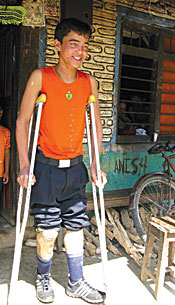 ICRC |
In October 2006, shortly after his Bhai Tika ceremony in a village 15km from Pokhara, Ram Chandra Biswakorma, a regular 15 year-old teenager was helping friends powder some small explosives for fishing.
No sooner had they begun the process, the plastic bucket which bore the chemicals exploded. When he opened his eyes, Ram found himself in hospital, wrapped in plasters and his two legs amputated. Six other boys were injured.
Today, he is no longer the fun-loving youngster that he was. He used to be good in studies, but is now lagging behind. He worries a lot about his future and feels sad that neither he nor his friends had ever received any education on the risks posed by mines
Like a lot of mine and Unexploded Ordnance (UXO) victims, Ram Chandra did not realise that he and his friends were in danger. The Maoists had formerly used their house as a storehouse for explosives and his story is repeated in the plight of many mine victims around the country.
The ten-year armed conflict has come to an end but it has left the threat of explosive remnants of war in its wake. In the first 10 months of this year alone, 58 people have been injured by mines in Nepal-most of them are children.
As part of its mandate to protect civilians from the effects of the conflict, the International Committee of the Red Cross (ICRC) is working to prevent injuries, assist victims and reduce the socio-economic impact of this lethal debris on civilian populations. It provides assistance for emergency and hospital care, secondary surgery and physical rehabilitation services to the victims of conflict if they fail to get support from the government.
The ICRC is working with the Green Pastures Hospital and Rehabilitation Centre (GPH&RC) in Pokhara, where Ram Chandra has been treated. Today, he has artificial limbs and can walk to and from school even without crutches. He is catching up with school work. His aim in life is to help put an end to the stigma the disabled face in Nepal and around the globe.
As part of the ICRC's Micro Economic Initiative (MEI) project, which provides cash for income generating projects for conflict-affected people, Ram Chandra's family received Rs 10,000 in kind. This grant can fund livestock, small-scale farming, trade or vocational training. Since it was launched in 2006, approximately 3,500 families in 35 districts have benefited.
Moheindu Chemjong
SEE ALSO:
'This land is mined land', #171
'Children in a minefield', #411


